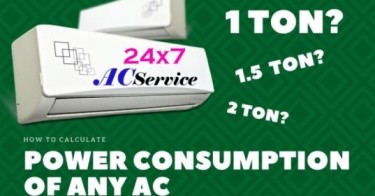The use of an air conditioner in the summer season is common everywhere because due to pollution the temperature of the earth’s surface has increased and it is continuously increasing year by year. As we all know AC provides relief and cooling in summers when scorching heat is at its peak. But using AC for long hours consumes a lot of electricity which creates a burden on your pockets. So here we will see the power consumption difference between 1 ton and 1.5-ton AC so that you can make your decision of choosing the right AC which suits you and your budget the most.
Before going ahead, If you are already using split or window ac and seeking the Carrier AC service, Daikin AC service, Onida AC Service, Haier AC Service, Godrej AC Service, we are here to help you. Now let’s move ahead with the topic.
What is Ton?
Ton is the unit of refrigeration in the air conditioner and if we go a little bit with basic physics, its unit is KJ/min or 3.5 KW. Let’s understand with an example: If you are using 1 ton AC the refrigeration process requires 210 KJ of energy through the heat which then results in the cooling effect of an equivalent amount.
The residential air conditioner might go between 1 to 5 tons whereas at the large industrial level the capacity can go as high as 800 tons.
Check Also:
- AC installation charges
- AC Gas filling charges
- AC Service in sonia Vihar
- AC Service in Rohini
- AC Service in Paschim Vihar
- AC Service in South Delhi
Clearly, one which burns through less force. As inverter AC is variable tonnage AC. It changes its tonnage according to the encompassing and room temperature. Along these lines, its energy efficiency is very acceptable and subsequently devours less force. While non-inverter AC constantly runs at full tonnage and consequently devours more force for a similar room cooling. In this way, Inverter AC is constantly suggested. Allows us currently to conclude whether it would be a good idea for us to purchase 3 STAR or 5 STAR AC?
Clearly, 5 STAR AC will have more energy efficiency and henceforth less power bill. Yet, the expense of 5 STAR AC is very higher when contrasted and 3 STAR AC.
Check Also:
Power consumption difference between 1 ton and 1.5-ton AC
Allow us to check the impact on our pocket thinking about the fixed and running expense of 5 STAR and 3 STAR AC. A correlation has been made by taking the cost of 1.5 ton AC. I just discovered this brand best from a presentation, sturdiness, and maintenance perspective.
Above all its cost is quite reasonable.
Average Cost of 5 Star AC = Rs. 47,000
Average Cost of 3 Star AC = Rs. 34,000
Saving (3 star inverter AC) = Rs. 13000 (If you buy 3 STAR Inverter AC)
Power consumption for 5 stars AC (Annual) – 1600 hours in a year – 767 Units or KWh
Power consumption for 3 stars AC (Annual) – 1600 hours in a year – 1045 Units or KWh
Average electricity unit per year (Rs 5 per unit)
Power Consumption for 5 stars split AC for the summer season (4 months x 15 hours) – 120×15 = 1800 hours
So, 767×1800/ 1600 – 863 Units or KWh
Power Consumption for 3 stars split AC for the summer season (4 months x 15 hours) – 120×15 = 1800 hours
So, 1045×1800/ 1600 = 1176 Units or KWh
Electricity bill for 5 star split AC = Rs 863×5 = Rs 4315
Electricity bill for 3 star split AC = Rs 1176×5 = Rs 5880
The difference in cost = Rs 5880 – Rs 4315 = 1565
Number of years in which we save Rs 13000 on electricity bill with 5 star AC = 13000/1565
= 8.3 Years
Conclusion
Now you can easily choose the variant for your home or office when you have a clear idea of the power consumption difference between 1 ton and 1.5-ton ac or electricity consumption difference between 1 ton and 1.5-ton ac. If you are in need of LG ac service, voltas ac service, Hitachi ac service, Panasonic AC Service, Whirlpool AC Service, Bluestar AC Service, you can contact us for the best and reliable service.



